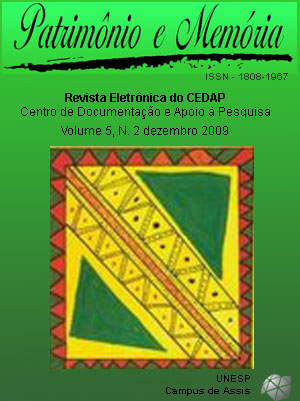HÉLIO SEREJO
HISTORY, MEMORY AND LANGUAGE
Keywords:
Memory, Langugae, SerejoAbstract
This article concerns the production of Hélio Serejo, a writer from the state of Mato Grosso do Sul, undeniably the most fertile archivist of a vast region of the western border of Brazil. Serejo left a cultural legacy to posterity in the form of over 60 books, which chart the work of the “erva-mate” harvest; its habits, food, myths, legends, related natural medicine and festivals’, relying on the tri-linguistic that forms the most genuine expression of life and speech habits of the border. His works register
an epoch (XIX and beginning of the XX centuries) in which the extraction of the ervamate was the economic engine that helped put this region on the road to civilization. For this essay, three works of the author have been selected. Together, they constitute a sort of synthesis of his collected works. In the realms of language, and with the aid of memory, we aim to learn about the movement of people in relation to the making of their history, within that region that separates Brazil from Paraguay in western Brazil.
References
ALVES, Gilberto Luiz. As funções da escola pública de educação geral sob o imperialismo. Novos Rumos, São Paulo, n. 16, p. 89-112, 1990.
BAKHTIN, Mikhail. Marxismo e filosofia da linguagem. Tradução de Michel Lahud e Yara Frateschi. 3. ed. São Paulo: Hucitec, 1986.
BARROS, Manoel de. Gramática expositiva do chão (poesia quase toda). Rio de Janeiro: Civilização Brasileira, 1990.
CANDIDO, Antonio. Literatura de dois gumes. In: ______. A educação pela noite e outros ensaios. 3. ed. São Paulo: Ática, 2000. p. 163-180.
CAMPESTRINI, Hidelbrando. Hélio Serejo, o trilhador de todos os caminhos. Campo Grande, MS: Instituto Histórico e Geográfico de Mato Grosso do Sul, 2008.
CENTENO, Carla V. Educação e fronteira com o Paraguai na historiografia mato-grossense (1870 - 1950). 2007. Tese (Doutorado) – Universidade Estadual de Campinas, Campinas, SP, 2007.
CENTENO, Carla V.; BRITO, Sílvia Helena Andrade de. A presença do trabalhador paraguaio nos ervais de Mato Grosso (1870 - 1930). In: ______. Educação e diversidade cultural. Campo Grande: Editora UNIDERP, 2004. p. 67.
FIGUEIRA, Pedro de Alcântara; MENDES, Claudinei M. M. Estudo preliminar: escravismo colonial. In: BENCI, Jorge S. J. Economia cristã dos senhores do governo dos escravos. São Paulo: Editorial Grijalbo, 1977. p. 7-38.
FLORENTINO, Ari. Folha de Dourados: Crônicas do Coração. s/p. Acesso em: 25 abr. 2008. Disponível em: http://www.folhadedourados.com.br/view.php?cod=23998.
LAFETÁ, João Luiz. O mundo à revelia – pósfacio. In: RAMOS, Graciliano. São Bernardo. 65. ed. Rio de Janeiro: Record, 1996. p. 200.
LUKÁCS, Georg. A teoria do romance: um ensaio filosófico sobre as formas da grande épica. Tradução, posfácio e notas de José Marcos Mariani de Macedo. São Paulo: Editora 34, [s.d.], p. 29.
MORETI, Ariane Morales. A representação feminina em 4 contos. Revista InterLetras, Dourados, MS, v. 2, n. 3, jul./dez. 2005. s/p. Acesso em: 24 abr. 2008. Disponível em: http://www.unigran.br/interletras/n3/cultura_brasil/rep_feminina.html.
NOLASCO, Paulo. O outdoor invisível: crítica reunida. Campo Grande: Editora UFMS, 2006. p. 207-213.
ROCHA, Guimarães. Cosmovisão das letras brasileiras em Hélio Serejo. Recanto das Letras, s/p. Acesso em: 25 abr. 2008. Disponível em: http://recantodasletras.uol.com.br/artigos/961923.
SEREJO, Hélio. Balaio de bugre. Presidente Venceslau: Requião, [197-?].
SEREJO, Hélio. Pelas orilhas da fronteira... Curitiba: Lítero-Técnica, 1981.
SEREJO, Hélio. Vida de erval. Campo Grande, MS: Instituto Histórico e Geográfico de Mato Grosso do Sul, 2008. v. IV, p. 72. (Coletânea Obras Completas).
SEREJO, Hélio. Vida de erval. São Paulo: Vaner Bícego, [197-?].
TENO, Neide Araújo Castilho. O estudo do vocabulário da erva-mate em obras de Hélio Serejo. 2003. Dissertação (Mestrado) – Universidade Federal de Mato Grosso do Sul, Dourados, MS, 2003. 171 p.
Downloads
Published
How to Cite
Issue
Section
License
Copyright (c) 2009 Patrimônio e Memória

This work is licensed under a Creative Commons Attribution 4.0 International License.
All the content of the journal, except where noted, is licensed under a Creative Commons BY attribution license.


